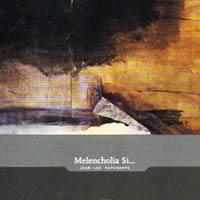Four Centuries Apart 3.
|
Walt Mundkowsky [September 2010.]
“Images of Melancholy.” Anthony HOLBORNE: The Teares of the Muses (1599); The Image of Melancholy (1599). Andrew WILSON-DICKSON: Fantasia ‘Lachrimae’ (1975); organ improvs. Giles FARNABY: Lachrimae Pavan John Dowland. John DOWLAND: Semper Dowland, semper dolens (1600?); Lachrimae or Seaven Teares (1604). Thomas WEELKES: Pavan Lachrimae. Readings from the Corpus Hermeticum by Hermes Trismegistus (rec. 2001). The English Fantasy Consort of Viols: Fiona Huggett, Angela Voss, Pamela Cresswell, Rosemary Thorndycraft, Imogen Seth-Smith (viols), Lynda Sayce (lute), Andrew Wilson-Dickson (org), John Line (reader). Riverrun Records RVRCD57 (http://www.rvrcd.com/home.html). This CD moves on alternating fronts, music in Dowland’s sphere and readings from the Corpus Hermeticum, attributed in the Renaissance to an ancient Egyptian sage. (It now seems the work of a committee several centuries later.) Line’s assured delivery compels, but he has to battle an organ noodling behind him. Organist Wilson-Dickson also offers a 1975 piece whose harmonic idiom jars — high-toned thriller music for viols. Solos from organ (Farnaby) and lute (Semper Dowland) stay earthbound. Happily, the remainder excels. The English Fantasy made only one other album (a 1995 Gaudeamus of Thomas Lupo), but their clean intonation and ensemble stand out. A pair of Holbornes is most welcome, but things snap into focus on track 13 with the onset of Dowland’s Seaven Teares — darker, more committed playing. The permutations are best caught when the seven are heard in a row, so keep the remote handy. Recommendations for Dowland’s entire Lachrimae 1604 (21 numbers) are thinner than they once were, since Savall / Hespèrion XX’s 1987 Astrée departed years ago. On viols, Fretwork (1987, ’89) is the clear choice, found only in a Virgin budget double with Byrd and scant notes; Lindberg / Dowland Consort (1985, BIS) is good. For ye violins (but not for me) some pieces are transposed up a fourth or a fifth. Peter Holman’s The Parley of Instruments (1992, now Helios) issues a strong case, and Holman wrote a useful book on the cycle (Dowland, Lachrimae (1604), Cambridge Music Handbooks). Also on Kindle! Andrew Manze’s talk on Seaven Teares is enhanced by Concordia’s accounts. A proper recording from them of the whole would be an event. The passages read from Book I of the Corpus Hermeticum used The Way of Hermes, a recent translation considered less stuffy than previous attempts.
Jean-Luc FAFCHAMPS: Melencholia Si… (1994-98); A garden (1996-97) (rec. 2001). Laurence Cornez, Stephane Ginsburgh (p), Kuniko Kato, Gerrit Nulens (perc); Ictus Wind Quintet: Janna Van Mechelen (fl), Piet Van Bockstal (ob, enhn), Benjamin Dieltens (clar), Bruce Richards (hn), Dirk Noyen (bsn). Sub Rosa SR 179 (http://www.subrosa.net/). As pianist, Fafchamps has well-regarded Feldman and Scelsi to his credit; I can admire a 1993 disc of late Liszt, Dallapiccola and Berio (Sub Rosa, O/P). He’s mainly a composer these days and Melencholia Si… fits my theme, if it hardly reflects his current direction. Dürer’s famous Melencolia I engraving of 1514 inspired it (I wish the era’s music had as well!). Two pianos and percussion suggest Crumb, not Bartók. Ceremonial gongs rule the opening movement (“Particules du jour”), and wood percussion leads the next. The best writing molds the deepening depression in the third (“Emptiness that does not let itself be tortured by a shape”), pianos foremost. A joyous conclusion — intricate passagework and pealing percussion — has me dreaming of Messiaen. A garden is modest and a bit unruly. Each of its brief movements spotlights a member of the wind quintet, lowest to highest (Van Mechelen’s flute turn is especially ripping). Not all clichés are avoided (the chuckling rapidity), but execution this distinctive helps. (The composer is the Ictus ensemble’s pianist.)
[More Four Centuries Apart, Walt Mundkowsky]
[Previous Article:
Mostly Symphonies 14.]
[Next Article:
Beethoven Piano Sonatas: Kempff Monos]
|

